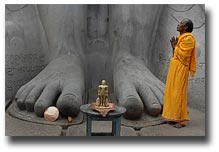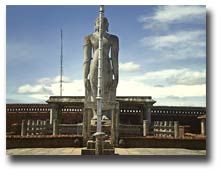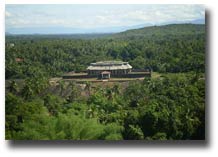Location :
The temple of Shravanabelagola is located 51 km south east of Hassan in Karnataka at an Altitude of about 3350 feet above sea level. There are excellent roads from Bangalore and Mysore. The nearest airport is Banglore which at a distance of 157 km. and the nearest railway station is Hassan. It is a little township tucked away between Indragiri and Chandragiri hills.
Significance of the Temple
This is the colossal rock cut statue of saint Gommata at Shravanabelagola is the most magnificent among all Jaina works of art. It was been built in circa 982 AD and is described as one of the mightiest achievements of ancient Karnataka in the realm of sculptural art. Also referred to as Lord Bahubali, the image is nude an stands upright in the posture of meditation known as kayotsarga, reaching a height of nearly 57 ft atop the Vindyagiri of Doddabetta hills accessible through a flight of 500 steps.
The image of Gommata has curly hair in ringlets and long, large ears. His eyes are open as if viewing the world with detachment. His facial features are perfectly chiseled with a faint touch of a smile at the corner of his lips and embody calm vitality. His shoulders are broad, his arms stretch straight down and the figure has no support from the thigh upwards.
There is an anthill in the background which signifies his incessant penance. From this anthill emerge a snake and a creeper which twine around both his legs and his arms culminating as a cluster of flowers and berries at the upper portion of the arms. The entire figure stands on an open lotus signifying the totality attained in installing this unique statue. On either side of Gommata stand two tall and majestic chauri bearers in the service of the Lord. One of them is a yakshi and the other one is a yakshi. There were richly ornamented and beautifully carved figures complement the main figure. Carved on the rear side of the anthill is also a trough for collecting water and other ritual ingredients used for the sacred bath of the image. Around the statue is an enclosure of a pillared hall where one can find 43 images of tirthankaras in different cloisters.

One the same hill can be seen the Chandraprabha Basadi dedicated to the 8th tirthankara by the same name. It is one of the oldest basadis on the hill and can be assigned to the early 9th century under the reign of Sivamara, a Ganga king.
While at Sravana Belgola one can also gain insights into Jaina mythology through some of the finest paintings depicted on the walls of the Sri Jains matha. Rich in colours and harmonious in composition, these paintings of the 18th century depict royal processions and festivities, monks, women in brightly coloured sarees, forest scenes of wild animals and other topics that shed light on the domestic, religious and social life of the people.

There are inscriptions on the slabs near the right and left foot of the image of Gommatesvara at Sravana BELGOLA. THE INSCRIPTION ON THE RIGHT HAND SLAB IS AS FOLLOWS :
- Sri-Chamundarajam madisidam;
- Sri-Chamundarajan "se" Yv 'v' ittan;
- Sri-Gamgaraja suttalayavam madisida;
That is "Sri Chamunda Raya established the image of Gomatesa in the city of Belgula, in Kumbha Lagna, on a sunday, the fifth day of the bright lunar fortnight, in the month of Chaitra, in the praised yera Vibbhava, in the Kalki age, known as 600, when the auspicious Mrigasirh star was visible." This date lies between a period 980-984 A.D.
| Nearby tourist places to Gomateshwara Temple Bangalore Hampi |
 |
How to reach the Temple
- The airport at Amritsar for reaching Golden Temple is named Raja Sani International Airport which offers excellent services. The airport here is well connected to other parts of the country by regular flights. Today Jet Airways, Turkmenistan, Uzbekistan and Air India also offer flights to Amritsar from Delhi, Birmingham and London.
- The Railways are also well established in Amritsar.. It takes about 8 to 10 hours to reach Amritsar by train from Delhi.
- By Road one can reach Amritsar through Grand Trunk Karnal Road which connects Delhi to Amritsar. Regular buses are available from I.S.B.T. Delhi to Amritsar. One can choose from local, semi deluxe, deluxe and super deluxe buses offered by the bus station.



